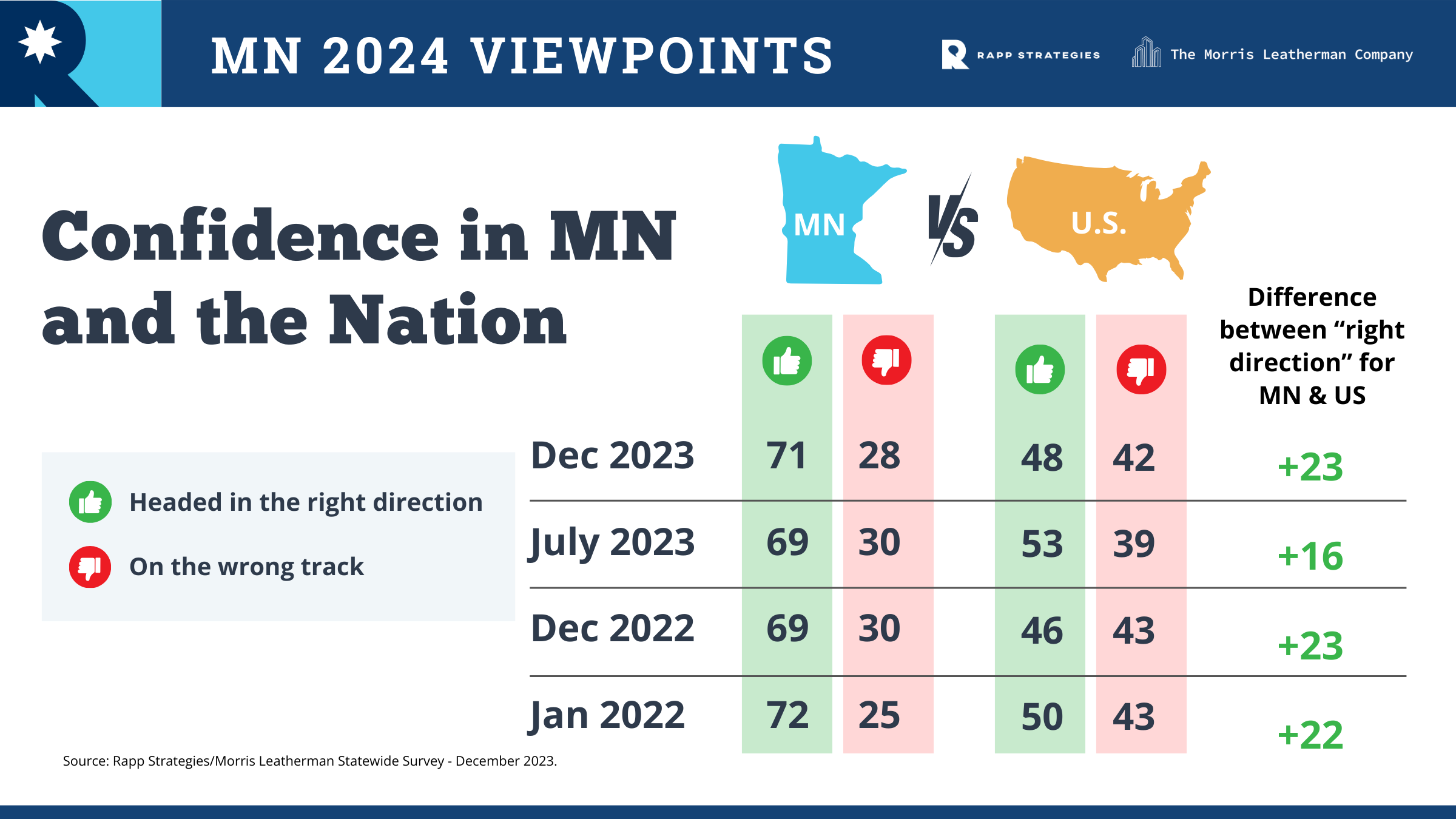MN 2024 Viewpoints: Political Atmospherics of Minnesota
Welcome to the first installment the MN 2024 Viewpoints series by Rapp Strategies and The Morris Leatherman Company. Today, we’re focusing on the most frequently used measurement in polling for general political atmosphere — the “right direction/wrong track” question — and what answers to this time-tested question tell us heading into a turbulent 2024 political year.
Generally, do you think [Minnesota/the United States] is heading in the right direction, or is it off on the wrong track?
Over the last few years, the most striking outcome from this question in our statewide polls is the distinction between the views Minnesotans have of their own state versus their views of the country as whole. Confidence in the direction of the country has wavered over the last two years, but confidence in the direction of Minnesota has remained rock solid.
If we dive deeper into the responses to the RD/WT questions from our December 2023 survey, the data reveal key differences in optimism among Minnesota’s political parties. For example, 94% of Democrats believe the state is headed in the right direction, compared to only 36% of Republicans. Interestingly, Independents (91% right direction) largely share Democrats’ optimism.
This strong optimism among both Democrats and Independents, combined with the popularity of Amy Klobuchar – the only statewide candidate up for reelection – suggest that Democrats are entering the long campaign season in a solid position.
Nationally, we see a different story. Just 18% of Republican respondents believe the country is headed in the right direction, compared to 70% of Democrats and 60% of Independents. This lower optimism across the board suggests that nearly half of Minnesotans are entering 2024 unsatisfied and potentially looking for something different nationally. Those who believe solid GOP voters may abandon Trump should look at these results carefully.
Notably, party identification appears to be a more reliable indicator of Minnesotans’ confidence than economic issues. We asked respondents to describe which of the following best described their financial situation:
A) Monthly expenses are exceeding your income
B) You are meeting monthly expenses, but are putting aside little or no savings
C) You are managing comfortably, while putting some money aside
D) You are managing very well
Respondents who answered “A” or “B” are considered to be “financially stressed”, and “C” or “D” respondents “financially comfortable.”
Sixty-seven percent of “financially stressed” respondents believe Minnesota is heading in the right direction, compared to 77% of the “financially comfortable.” Likewise, fifty percent of the financially stressed are confident in the direction of the nation, compared to 47% of those who are comfortable.
Finally, 14% of respondents to our survey believe Minnesota is heading in the right direction, but the nation is not. These respondents are younger and more progressive than the average Minnesotan, but it is unclear whether their national dissatisfaction is driven by frustrations with the GOP agenda or President Biden, or both.
Interested in learning more about which issues Minnesotans care most about? Tune back in tomorrow for a deeper look at which issues Minnesotans from each party are prioritizing.
Have questions about our findings or want to learn more about how Rapp Strategies and The Morris Leatherman Company can elevate the strategy of your organization? Get in touch at info@rappstrategies.com.
Results are based on Rapp Strategies and The Morris Leatherman Company’s statewide survey, conducted December 8-20, 2023. The study contains the results of a random sample of 800 randomly selected adult residents in the State of Minnesota, interviewed via telephone. Cell phone-only households were 54% of the sample, while landline-only households were 9%. Results of the sample reflect the entire population of Minnesota based on census data. Results were not reweighted, and are projectable to all Minnesotans with a margin of error of ±3.5% in 95 out of 100 cases.



